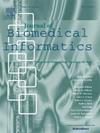Ontology-driven identification of inconsistencies in clinical data: A case study in lung cancer phenotyping
IF 4
2区 医学
Q2 COMPUTER SCIENCE, INTERDISCIPLINARY APPLICATIONS
引用次数: 0
Abstract
Objective:
To illustrate the use of an ontology in evaluating data quality in the medical field, focusing on phenotyping lung cancers.
Materials and Methods:
We crafted an ontology to encapsulate crucial domain knowledge, leveraging it to query the Clinical Data Warehouse (CDW) of Bordeaux University Hospital. Our work aimed at accurately representing domain knowledge and identifying inconsistencies through ontological axioms. Specifically, our aim was to pinpoint lung cancer patients with EGFR or ALK mutations treated with tyrosine kinase inhibitors (TKIs). We evaluated the ability of this ontology to retrieve and characterize patients in comparison with a traditional SQL queries executed on the CDW.
Results:
The ontology’s results closely aligned with those of the SQL queries. A sub-cohort of 60 lung cancer patients with conflicting information was identified, highlighting inconsistencies in the data. Moreover, the ontology complemented the existing data, uncovering additional information and enriching the dataset.
Discussion:
This work has highlighted challenges in managing temporal data and handling imperfect data. Addressing these challenges is essential for the effective use of CDW in phenotyping.
Conclusion:
Ontologies improve data quality by identifying inconsistencies, enhancing data completeness, facilitating complex SQL queries, and standardize processes. Developing a framework to manage inconsistent healthcare data, considering its temporal nature, is essential.

临床数据不一致的本体驱动识别:肺癌表型的一个案例研究。
目的:阐述本体论在医学领域数据质量评估中的应用,重点是肺癌的表型分析。材料和方法:我们制作了一个本体来封装关键的领域知识,利用它来查询波尔多大学医院的临床数据仓库(CDW)。我们的工作旨在通过本体论公理准确地表示领域知识并识别不一致性。具体来说,我们的目标是确定使用酪氨酸激酶抑制剂(TKIs)治疗EGFR或ALK突变的肺癌患者。与在CDW上执行的传统SQL查询相比,我们评估了该本体检索和表征患者的能力。结果:本体的结果与SQL查询的结果密切一致。一个由60名肺癌患者组成的亚队列中发现了相互矛盾的信息,突出了数据的不一致性。此外,本体补充了现有数据,揭示了额外的信息,丰富了数据集。讨论:这项工作突出了管理时间数据和处理不完善数据方面的挑战。解决这些挑战对于CDW在表型分析中的有效应用至关重要。结论:本体通过识别不一致性、增强数据完整性、简化复杂的SQL查询和标准化流程来提高数据质量。考虑到不一致的医疗保健数据的时间性质,开发一个框架来管理这些数据至关重要。
本文章由计算机程序翻译,如有差异,请以英文原文为准。
求助全文
约1分钟内获得全文
求助全文
来源期刊

Journal of Biomedical Informatics
医学-计算机:跨学科应用
CiteScore
8.90
自引率
6.70%
发文量
243
审稿时长
32 days
期刊介绍:
The Journal of Biomedical Informatics reflects a commitment to high-quality original research papers, reviews, and commentaries in the area of biomedical informatics methodology. Although we publish articles motivated by applications in the biomedical sciences (for example, clinical medicine, health care, population health, and translational bioinformatics), the journal emphasizes reports of new methodologies and techniques that have general applicability and that form the basis for the evolving science of biomedical informatics. Articles on medical devices; evaluations of implemented systems (including clinical trials of information technologies); or papers that provide insight into a biological process, a specific disease, or treatment options would generally be more suitable for publication in other venues. Papers on applications of signal processing and image analysis are often more suitable for biomedical engineering journals or other informatics journals, although we do publish papers that emphasize the information management and knowledge representation/modeling issues that arise in the storage and use of biological signals and images. System descriptions are welcome if they illustrate and substantiate the underlying methodology that is the principal focus of the report and an effort is made to address the generalizability and/or range of application of that methodology. Note also that, given the international nature of JBI, papers that deal with specific languages other than English, or with country-specific health systems or approaches, are acceptable for JBI only if they offer generalizable lessons that are relevant to the broad JBI readership, regardless of their country, language, culture, or health system.
 求助内容:
求助内容: 应助结果提醒方式:
应助结果提醒方式:


